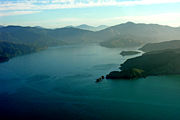
Port Underwood
Encyclopedia

Cloudy Bay
Cloudy Bay is located at the northeast of New Zealand's South Island, to the south of the Marlborough Sounds. The area lends its name to one of the best known New World white wines although the grapes used in production of that wine are grown in the Marlborough wine region further inland.The bay...
at the northeast of New Zealand
New Zealand
New Zealand is an island country in the south-western Pacific Ocean comprising two main landmasses and numerous smaller islands. The country is situated some east of Australia across the Tasman Sea, and roughly south of the Pacific island nations of New Caledonia, Fiji, and Tonga...
's South Island
South Island
The South Island is the larger of the two major islands of New Zealand, the other being the more populous North Island. It is bordered to the north by Cook Strait, to the west by the Tasman Sea, to the south and east by the Pacific Ocean...
, on the east coast of the Marlborough Sounds
Marlborough Sounds
The Marlborough Sounds are an extensive network of sea-drowned valleys created by a combination of land subsidence and rising sea levels at the north of the South Island of New Zealand...
. With only a relatively narrow entrance to the south-south-east it is sheltered from almost all winds. Originally considered part of Cloudy Bay
Cloudy Bay
Cloudy Bay is located at the northeast of New Zealand's South Island, to the south of the Marlborough Sounds. The area lends its name to one of the best known New World white wines although the grapes used in production of that wine are grown in the Marlborough wine region further inland.The bay...
the port was named after Joseph Underwood of the shipping firm Kabel and Underwood in the early 19th century.
There is evidence of a large Māori population at various times prior to European arrival in New Zealand. In the 1820s the local Rangitane were defeated by the Ngāti Toa
Ngati Toa
Ngāti Toa , an iwi , traces its descent from the eponymous ancestor Toarangatira. The Ngāti Toa region extends from Miria-te-kakara at Rangitikei to Wellington, and across Cook Strait to Wairau and Nelson....
chief Te Rauparaha
Te Rauparaha
Te Rauparaha was a Māori rangatira and war leader of the Ngāti Toa tribe who took a leading part in the Musket Wars. He was influential in the original sale of conquered Rangitane land to the New Zealand Company and was a participant in the Wairau Incident in Marlborough...
. Sealers first visited about 1826 and were followed immediately by whalers
Whaling
Whaling is the hunting of whales mainly for meat and oil. Its earliest forms date to at least 3000 BC. Various coastal communities have long histories of sustenance whaling and harvesting beached whales...
. John Guard
John Guard
John 'Jacky' Guard was an English convict sent to Australia who was one of the first European settlers in the South Island of New Zealand, working as a whaler and trader.-Early life:...
, who had started a whaling station in Tory Channel
Tory Channel
Tory Channel is one of the drowned valleys that form the Marlborough Sounds in New Zealand.Tory Channel is named after the "Tory", a pioneer ship that brought British colonists to Wellington in 1840. It lies to the south of Arapawa Island, separating it from the mainland. At its western end it...
the previous year, set up a subsidiary station at Kakapo Bay in 1828. By 1840 there were approximately 150 Europeans in the area, probably the largest concentration in the South Island
South Island
The South Island is the larger of the two major islands of New Zealand, the other being the more populous North Island. It is bordered to the north by Cook Strait, to the west by the Tasman Sea, to the south and east by the Pacific Ocean...
at that time.
On 16 June HMS Herald arrived with Major
Major
Major is a rank of commissioned officer, with corresponding ranks existing in almost every military in the world.When used unhyphenated, in conjunction with no other indicator of rank, the term refers to the rank just senior to that of an Army captain and just below the rank of lieutenant colonel. ...
Thomas Banbury on board bringing the Treaty of Waitangi
Treaty of Waitangi
The Treaty of Waitangi is a treaty first signed on 6 February 1840 by representatives of the British Crown and various Māori chiefs from the North Island of New Zealand....
for the South Island
South Island
The South Island is the larger of the two major islands of New Zealand, the other being the more populous North Island. It is bordered to the north by Cook Strait, to the west by the Tasman Sea, to the south and east by the Pacific Ocean...
chiefs to sign. This took place on Horahora-Kakahu Island just offshore from the eastern shoreline. The only European to sign the Treaty as one of the cedants, John Thomas, son-in-law of Te Rauparaha
Te Rauparaha
Te Rauparaha was a Māori rangatira and war leader of the Ngāti Toa tribe who took a leading part in the Musket Wars. He was influential in the original sale of conquered Rangitane land to the New Zealand Company and was a participant in the Wairau Incident in Marlborough...
's elder brother Nouhora, signed on the 16th. Nouhora himself, initially reluctant to sign, did so on 17 June. A commemorative bronze plaque marking the occasion was unveiled here on 3 October 1964.

